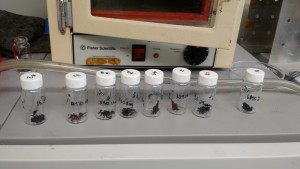Determining the Ion exchange capacities (IECs) of certain membranes are what our work has focused on during this second week. We made a few membranes by mixing certain amounts of Polyvinyl Alcohol (PVA) and sulfosuccinic acid (SSA) and leaving the resulting solutions in an oven for 24 hours. We made a total of 12 membranes and determined their IECs. The IEC of a membrane is important because it affects how well the membrane can do its job of preventing ion backflow during Membrane Capacitive Deionization (MCDI). We have not carried out any MCDI trials yet for the membranes. We will do that in the upcoming weeks.
8 of the membranes in their vials
The lab has also ordered the parts for a flow coater device and those should be arriving in the next few weeks. Once we have the parts we will have to assemble the flow coater in order to use it to coat our electrodes with the membranes for MCDI trials.
Until next week
T
